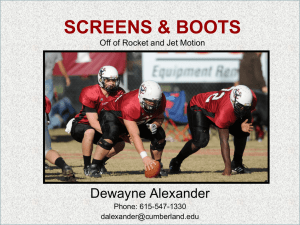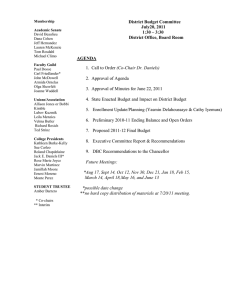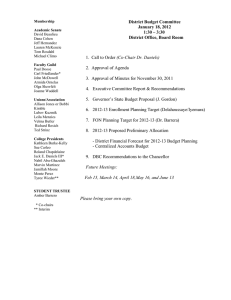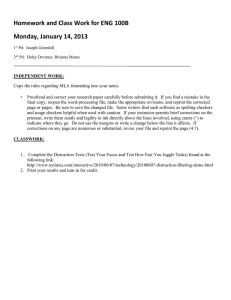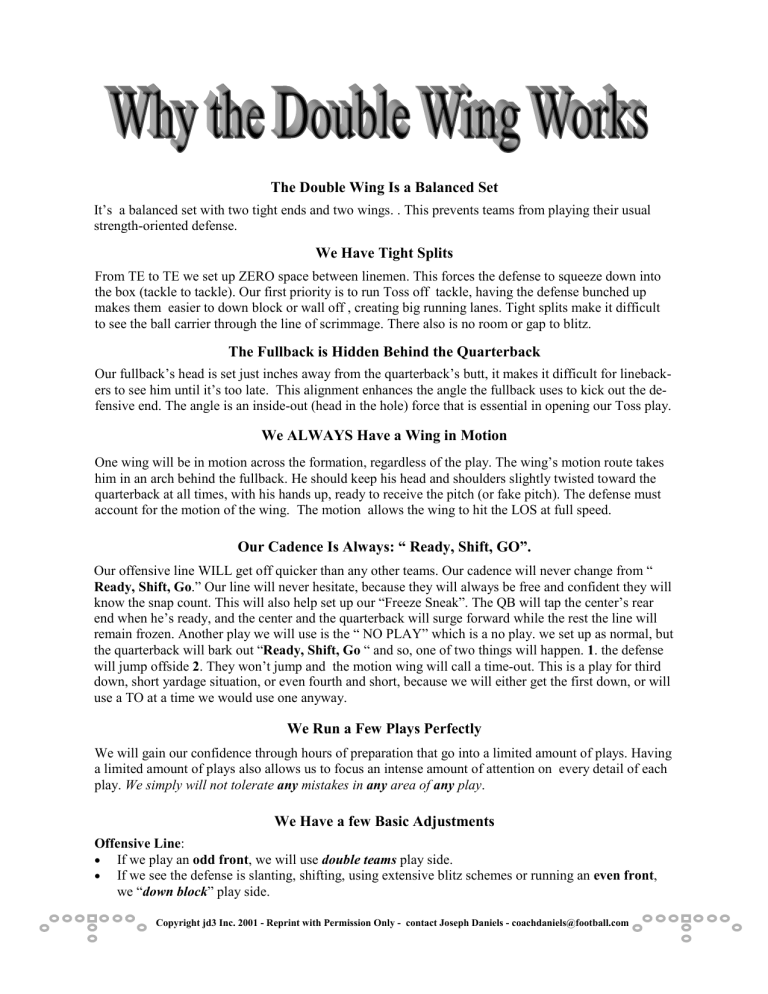
The Double Wing Is a Balanced Set It’s a balanced set with two tight ends and two wings. . This prevents teams from playing their usual strength-oriented defense. We Have Tight Splits From TE to TE we set up ZERO space between linemen. This forces the defense to squeeze down into the box (tackle to tackle). Our first priority is to run Toss off tackle, having the defense bunched up makes them easier to down block or wall off , creating big running lanes. Tight splits make it difficult to see the ball carrier through the line of scrimmage. There also is no room or gap to blitz. The Fullback is Hidden Behind the Quarterback Our fullback’s head is set just inches away from the quarterback’s butt, it makes it difficult for linebackers to see him until it’s too late. This alignment enhances the angle the fullback uses to kick out the defensive end. The angle is an inside-out (head in the hole) force that is essential in opening our Toss play. We ALWAYS Have a Wing in Motion One wing will be in motion across the formation, regardless of the play. The wing’s motion route takes him in an arch behind the fullback. He should keep his head and shoulders slightly twisted toward the quarterback at all times, with his hands up, ready to receive the pitch (or fake pitch). The defense must account for the motion of the wing. The motion allows the wing to hit the LOS at full speed. Our Cadence Is Always: “ Ready, Shift, GO”. Our offensive line WILL get off quicker than any other teams. Our cadence will never change from “ Ready, Shift, Go.” Our line will never hesitate, because they will always be free and confident they will know the snap count. This will also help set up our “Freeze Sneak”. The QB will tap the center’s rear end when he’s ready, and the center and the quarterback will surge forward while the rest the line will remain frozen. Another play we will use is the “ NO PLAY” which is a no play. we set up as normal, but the quarterback will bark out “Ready, Shift, Go “ and so, one of two things will happen. 1. the defense will jump offside 2. They won’t jump and the motion wing will call a time-out. This is a play for third down, short yardage situation, or even fourth and short, because we will either get the first down, or will use a TO at a time we would use one anyway. We Run a Few Plays Perfectly We will gain our confidence through hours of preparation that go into a limited amount of plays. Having a limited amount of plays also allows us to focus an intense amount of attention on every detail of each play. We simply will not tolerate any mistakes in any area of any play. We Have a few Basic Adjustments Offensive Line: • If we play an odd front, we will use double teams play side. • If we see the defense is slanting, shifting, using extensive blitz schemes or running an even front, we “down block” play side. Copyright jd3 Inc. 2001 - Reprint with Permission Only - contact Joseph Daniels - coachdaniels@football.com Our Blocking Schemes Allow Constant Victory Most offensive plays are designed to depend on one or two blockers moving their defensive opponent away from the point of attack. We use a team attack , we use most if not all eleven men at the point of attack. If a player is not involved in the point of attack, he is running GREAT fakes. We depend on down blocking and double team blocks. We will also use a trap or kick-out blocks, and our most effective Counter/Power blocking of pulling our backside guard AND tackle. We do not need any one lineman to take his man head up and depend on sheer force to move him one way or the other. We Demand GREAT FAKES We demand good fakes from our tight ends in decoy routes. We will ask our backs to follow through with fakes for at least 10 yards. We will stress crisp ball handling by our quarterback and even ask him to carry out a fake throwing motion to coincide with our tight end’s decoy route. Faking helps to minimize the defenders at the point of attack .one great fake we can draw away three or four potential tacklers away from the play. If we have two or three fakes you can figure we have the defense ‘s 11 scat- Copyright jd3 Inc. 2001 - Reprint with Permission Only - contact Joseph Daniels - coachdaniels@football.com Alignment and Numbering of the Backs 2 Back and 4 Back The Wings ♦ ♦ ♦ ♦ In a 2-Point stance, hands on the thigh Pads Eyes Up No Forward Lean ,Heels on the Ground Turned in at 45 degrees, Facing the Tight End (Almost to reach out and touch the TE’s Butt) 3 Back The Fullback ♦ ♦ ♦ 3 Point Stance Tail Down Eyes Up Not Quite Able to Reach Out with Down Hand and Touch the QB’s Butt 1 Back The Quarterback ♦ ♦ Feet as Far Back as Possible, Extend the Arms to Avoid Collisions with Pulling Guards Narrow Stance to Make pivoting easier Copyright jd3 Inc. 2001 - Reprint with Permission Only - contact Joseph Daniels - coachdaniels@football.com Copyright jd3 Inc. 2001 - Reprint with Permission Only - contact Joseph Daniels - coachdaniels@football.com Copyright jd3 Inc. 2001 - Reprint with Permission Only - contact Joseph Daniels - coachdaniels@football.com Copyright jd3 Inc. 2001 - Reprint with Permission Only - contact Joseph Daniels - coachdaniels@football.com Wing On/Off Shifts On “Ready” After the Shift 2 UP 4 UP 2 OFF 4 Off Double Off Double Up Copyright jd3 Inc. 2001 - Reprint with Permission Only - contact Joseph Daniels - coachdaniels@football.com Line Basics 9 7 5 3 ODD– Left 1 0 2 4 6 EVEN– Left 1. Linemen are in 3-Point Stances - Inside Hand Down ♦ ♦ ♦ ♦ ♦ ♦ The down hand is directly in front of the back foot Ends and Tackles have a Pronounced Heel-Toe Stagger ♦ Guard’s stagger is less pronounced The feet are no wider than shoulder width Very Little Weight on the Hands Off Arm resting on Knee EYES UP, TAILS DOWN 2. Linemen are Back Off the Ball as much as LEGAL ♦ ♦ ♦ Rule : The tops of the helmets must be even with the Center’s waist Guards Down Hand are even with some part of the Center’s feet Guards get set FIRST, Then Tackles, Then Ends to prevent bowing backwards 3. Line Splints are MAXIMUM 6 INCHES Copyright jd3 Inc. 2001 - Reprint with Permission Only - contact Joseph Daniels - coachdaniels@football.com 8 Left Motions Motion Right Motions Liz Rip Liz-Stop Rip-Stop Liz-Return Rip-Return Liz-Lead Rip-Lead Laser Rocket Louie Roscoe West Copyright jd3 Inc. 2001 - Reprint with Permission Only - contact Joseph Daniels - coachdaniels@football.com East Copyright jd3 Inc. 2001 - Reprint with Permission Only - contact Joseph Daniels - coachdaniels@football.com Run Blocking Basics Double Wing Blocking Concepts We Pry the Hole Open By ♦ Blocking Down ♦ Pulling the Backside to form the Wall Inside ♦ Kicking Out to Form the Outside Wall C or Counter: Backside guard kicks out playside Toss and Power: Backside guard and Tackle Pull and Wall Off Inside Cut and Trap: Backside guard or Tackle Pulls and Kicks Out an playside Defensive Lineman. Playside Linemen release onto linebackers and leave the Defensive lineman unblocked Copyright jd3 Inc. 2001 - Reprint with Permission Only - contact Joseph Daniels - coachdaniels@football.com Run Blocking Basics G: Playside guard kicks out point of attack, all other linemen block down O: Only Opposite or backside guard Walls Off G-O: Combo of BOTH Guards WEDGE: Formation of a wedge with all of the lines force concentrated on one poor defensive lineman Copyright jd3 Inc. 2001 - Reprint with Permission Only - contact Joseph Daniels - coachdaniels@football.com Run Blocking Basics X or Cross, Exchange: Tackle coming Down FIRST and the Guard Kick Out SECOND Tackle Trap: BackSide Tackle Kicks Out on the PlaySide interior Defensive Lineman– Same as Cut or trap. Copyright jd3 Inc. 2001 - Reprint with Permission Only - contact Joseph Daniels - coachdaniels@football.com Blocking the “Eagle” Look This Look puts our basic “Odd Double, Even Down” Rules in Conflict. So we will handle this look in one of the possible ways 1. Down Block 2. O call on Powers and Tosses Down Everyone (GCG) blocks DOWN . We have a predetermined call beginning with the letter ‘D” such as Delaware, Don, or just plain ol’ DOWN Everyone else blocks as normal but the BackSide Tackle DOES NOT PULL, He cuts off the man over the Guard. Copyright jd3 Inc. 2001 - Reprint with Permission Only - contact Joseph Daniels - coachdaniels@football.com The First Step... To making the Play PlaySide Type of Step Drive Step Drop Step Open Step Side Step Jab Step Copyright jd3 Inc. 2001 - Reprint with Permission Only - contact Joseph Daniels - coachdaniels@football.com First Check Chart Assignment Correct 1st Step Correct Foot Area Jab PlaySide Area Away Jab PlaySide CrossField Drive PlaySide Backer Drive PlaySide ON Drive PlaySide Reach Drive PlaySide Down Open Inside Gap Open Inside Man Away Open BackSide Read Up Open Inside Trap Open PlaySide Cut Off Open PlaySide Pull And.... Drop PlaySide Backer Side Inside Hold Side Inside Hinge Side Inside Copyright jd3 Inc. 2001 - Reprint with Permission Only - contact Joseph Daniels - coachdaniels@football.com And the Right Foot... To making the Play PlaySide Which Foot PlaySide Inside Foot BackSide: usually pertains to the center only Copyright jd3 Inc. 2001 - Reprint with Permission Only - contact Joseph Daniels - coachdaniels@football.com
